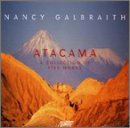| All Artists: Nancy Galbraith, Denis Colwell, Jesus Medina, Carnegie Mellon Wind Ensemble, Luz Manriquez, Patricia Prattis Jennings Title: Nancy Galbraith: Atacama (A Collection of Five Works) Members Wishing: 0 Total Copies: 0 Label: Albany Records Release Date: 2/25/2003 Genre: Classical Styles: Chamber Music, Historical Periods, Classical (c.1770-1830) Number of Discs: 1 SwapaCD Credits: 1 UPC: 034061055624 |
Search - Nancy Galbraith, Denis Colwell, Jesus Medina :: Nancy Galbraith: Atacama (A Collection of Five Works)
 | Nancy Galbraith, Denis Colwell, Jesus Medina Nancy Galbraith: Atacama (A Collection of Five Works) Genre: Classical
|
Larger Image |
CD Details |
CD ReviewsAn exciting new composer J Scott Morrison | Middlebury VT, USA | 02/28/2003 (5 out of 5 stars) "Nancy Galbraith is a Pittsburgh composer whom I'd never heard of before. But I'm glad I obtained this recording because she's really quite good. This disc contains a flute sonata, a string quartet, a 'wind symphony,' a major piano sonata, and two Latin dances for wind octet. And each one is worth listening to. 'Atacama', the flute sonata is a 17:30 minute, three movement work, played by two Chilean musicians to whom it is dedicated. In the first movement, Capricho, the flute is asked to bend notes in a manner reminiscent of those haunting wooden Andean flutes. In addition the flute goes on dizzying, dazzling flights, twittering like a demented bird. Later, in the second movement, Nocturno - 'in memory of the missing,' a reference to the Desaparecidos (The Disappeared Ones) of Latin America - has the unusual form of a short duet for flute/piano, followed by a long unaccompanied flute solo, then a long piano solo which ends serenely with the flute keening softly in its highest register; I even wondered if the flutist had picked up a piccolo. The last movement, Volante, has rapid repeated notes in the flute like the rapid heartbeat of a frightened animal, a tender middle section that leads back to a reminiscence of the initial agitated section. The string quartet, subtitled 'Inquiet Spirits,' is in a tightly constructed single arch form movement: Introduction A B C B A Coda (the latter recalling the Introduction). It is the most Bartókian of the pieces on this disc, and utilizes those familiar Bartók techniques like snap pizzicati and high glisses. It is solidly constructed and played brilliantly by Cuarteto Latinoamericano for whom it was written. The Wind Symphony is, for me, the least attractive of the pieces on the disc although this old euphonium player loved the tune given to the solo euphonium in the second movement. It is skillfully crafted and one appealing feature is the repeated use of delicate xylophone and marimba filigree. The third and final movement has an exciting brass, high winds and percussion fanfare that eventually ends with a muted low brass chorale over the quiet ticking of a snare drum. Dos Danzas Latinas are just that - a habañera and a samba. I challenge you to keep from moving to the sensuous rhythms of these dances expertly written for wind octet and played beautifully by a Mexican group, Sinfonietta Ventus. For me the major piece here is the 15:36 minute Piano Sonata No. 1 in three movements. The first movement is a slowed-down first cousin to the fugue in the Barber Piano Sonata; it starts excitedly, quiets down to a lyrical middle section and then ends with the fugue theme in Bach/Busoni octaves in the bass. The middle movement, Religioso, begins with a medieval open-fifths chant decorated by a disjunct, slightly eerie descant. It builds to an intense climax in two-handed chords with more and more added notes until they eventually become tone clusters - exciting! The movement ends quietly and with a sense of a journey taken. The last movement is a toccata with the brutal rhythms and harmonies of Revueltas's 'Sensemaya' (or perhaps 'Rite of Spring'), even more exciting than the preceding movement! This sonata takes major technique and pianist Chapman has it. This disc, with pieces from several genres recorded in a number of different venues in clear, lifelike sound by Albany Records, convinces me that Nancy Galbraith has an original voice that deserves to be heard." Lend an Ear Keith Otis Edwards | Dearbron, MI United States | 12/03/2007 (5 out of 5 stars) "Ms. Galbraith is not my favorite living composer, but she does get the job done. She has a mastery of Latin rhythms, and when she's not being Latin, the influence of Samuel Barber is discernible. What higher praise can one offer? It's a shame that school bands neglect her wind symphony in favor of the banal and unoriginal music from Hollywood."
|

 Track Listings (12) - Disc #1
Track Listings (12) - Disc #1